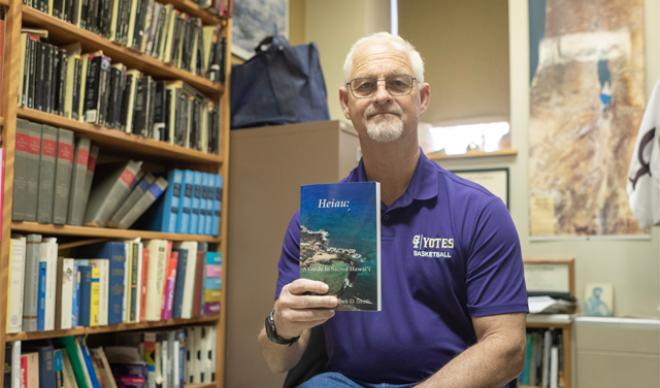
Dr. Mark Smith sat in his office in Strahorn Hall in February, holding his new book, “Heiau: A Guide to Sacred Hawai'i.” The book, released in January, is rooted in a thought Smith had during a 1994 study trip to the islands for the College.
“I was mystified by some structures that I saw in Hawai'i,” the long-time history professor said. “And I got curious about how and when did humans first get to Hawai'i. The next curiosity had to do with both ancient and less-ancient Hawaiian religion.”
The curiosities lit the spark and Smith began researching those questions. He had planned a sabbatical in 2002 to immerse himself in his research for the book but a transition to administration (Smith served as the Vice President of Academic Affairs at the College from 2003 to 2012) caused him to pause until he returned to teaching.
“My first few years of researching Hawaii was looking at the ‘Christianization’ of Hawai'i,” Smith said. “Then I realized a lot of people have done a lot of work in that, it’s fairly well-documented, but they’re engaging in a culture that’s older. What was that pre-contact religion like?”
As a result, he shifted back to his areas of expertise.
“I’m a historian, I’m an archaeologist, and I also have a degree in religious studies,” he continued. “Those three tend to triangulate and give a different approach.”
He wanted a book that could take a story about an archaeological site and be able to relate it back to early Hawaiian culture and religion. The triangulation of history (the story), archaeology (the site), and its early origins (the religion).
“That’s where my dissatisfaction came. I didn’t feel that I had a handle on it,” Smith explained. “That’s what I was looking for and then I realized it hadn’t been written.”
He wanted a guidebook. But not a guide to beaches and surfing. Rather a guide of sites, explaining their importance in Hawaiian culture.
Smith went to work cobbling together existing research and resources to go along with new research and conversations, including getting in a small airplane and flying over some of these areas to gather aerial photographs. He explained how some context of the sites was much more understandable from above, where he could see the geography and topography as a whole, rather than trying to understand it from the ground. He also emphasized the importance of respect for the sites, given their significance to the people of Hawai'i.
“These are sacred sites,” he said. “There is a lot of cultural sensitivity around these things.”
Smith says the finished product could be part of a future winter-term journey to Hawai'i, where students would likely be led by himself and biology professor Luke Daniels, combining multiple academic disciplines with the culture of the 50th and (to this point) final state to join the United States.
The book is available on Amazon for Kindle or in paperback.
The College of Idaho has a 133-year-old legacy of excellence. The College is known for its outstanding academic programs, winning athletics tradition, and history of producing successful graduates, including eight Rhodes Scholars, three governors, and countless business leaders and innovators. Its distinctive PEAK Curriculum challenges students to attain competency in the four knowledge peaks of humanities, natural sciences, social sciences, and a professional field—empowering them to earn a major and three minors in four years. The College’s close-knit, residential campus is located in Caldwell, where its proximity both to Boise and to the world-class outdoor activities of southwest Idaho’s mountains and rivers offers unique opportunities for learning beyond the classroom. For more information, visit www.collegeofidaho.edu.